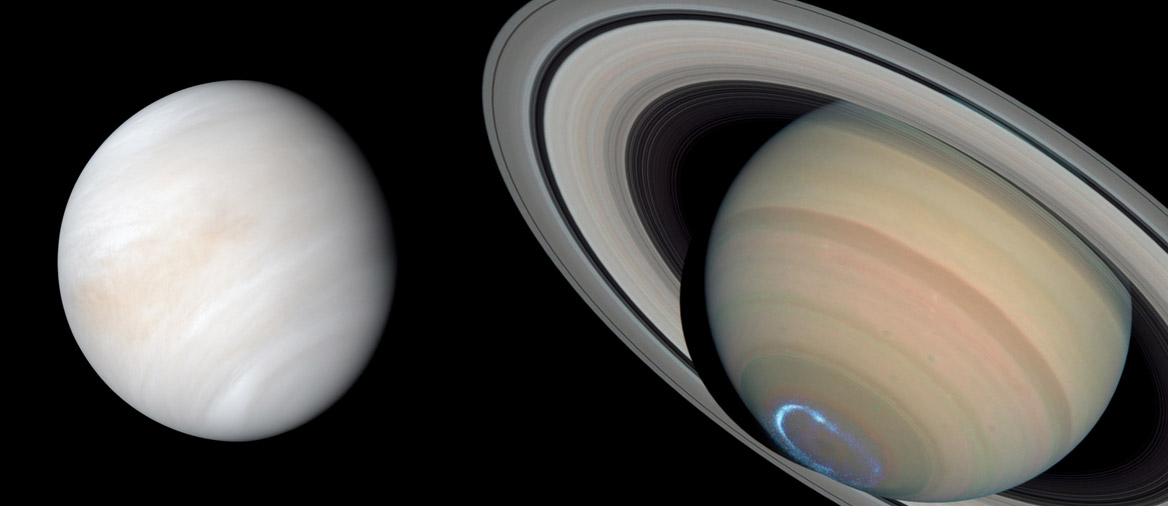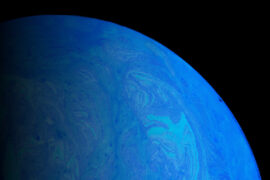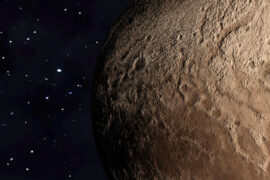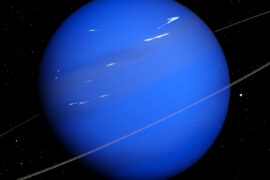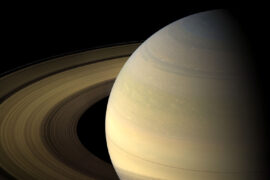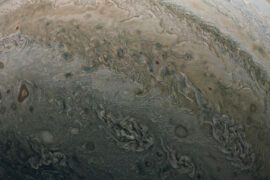Venus and Saturn are two of the most prominent planets in the night sky. They can both be observed without help from a telescope but they can be tricky to catch. Venus is quite bright and easy to find but only appears for short periods of time near the sunrise and sunset. Saturn, on the other hand, is the farthest planet that can be seen with the unaided eye and is only visible when its orbit takes it closer to Earth.
At first sight, both of these planets seem very different. One is a rocky, small, hot planet that is close to the Sun, and the other is a giant planet made up of gas with rings around it and a very cold environment.
But as you will find, even these two planets share some things in common like all the other planets in the Solar system. It is important to remember that all the planets formed at the same time and out of the same cloud of gas and dust. That means they have at least their origin in common even though they evolved very differently.
In this article, we’ll take a look at the differences and similarities between Venus and Saturn so we can learn more about these two planets.
Venus vs Saturn comparison
| Venus | Saturn | |
|---|---|---|
| Position in the Solar system | 2 | 6 |
| Distance from the Sun (avg) | 108 million km | 1,460 million km (1.46 billion km) |
| Radius | 6,051 km | 58,232 km |
| Mass | 4.8675×1024 kg | 5.6834×1026 |
| Rotation period (1 day) | 243 days | 10.5 hours |
| Rotation speed | 6.52 km/h | 35,500 km/h |
| Orbit period (1 year) | 224.7 days | 29.4 years (10,759 days) |
| Orbital speed | 35.02 km/s | 9.68 km/s |
| Average temperature (outer) | 464 °C | -140 °C |
| Surface pressure | 9,300 kPa | 140 kPa |
| Surface gravity | 8.9 m/s2 | 10.44 m/s2 |
| Density | 5.24 g/cm3 | 0.687 g/cm3 |
| Escape Velocity | 10.36 km/s | 35.5 km/s |
| Albedo | 0.689 | 0.342 |
| Satellites (Moons) | 0 | 145 |
| Core | rock | rock (unconfirmed) |
| Atmosphere | 96.5% CO2, 3.5% N | 75% H, 25% He |
Venus and Saturn size comparison
The difference in size between Venus and Saturn is remarkable.
Saturn is the second biggest planet in the Solar system, just behind Jupiter. Venus, on the other hand, is the sixth biggest (or the third smallest), it is only larger than Mercury and Mars.
Saturn has a diameter of 116,464 kilometers (72,367 miles). Venus has a diameter of 12,102 kilometers (7,520 miles). This means that if you were to line up 10 Venus-sized planets, they would just cover the width of one Saturn. This means that in volume, you could fit Venus about 890 times into Saturn.
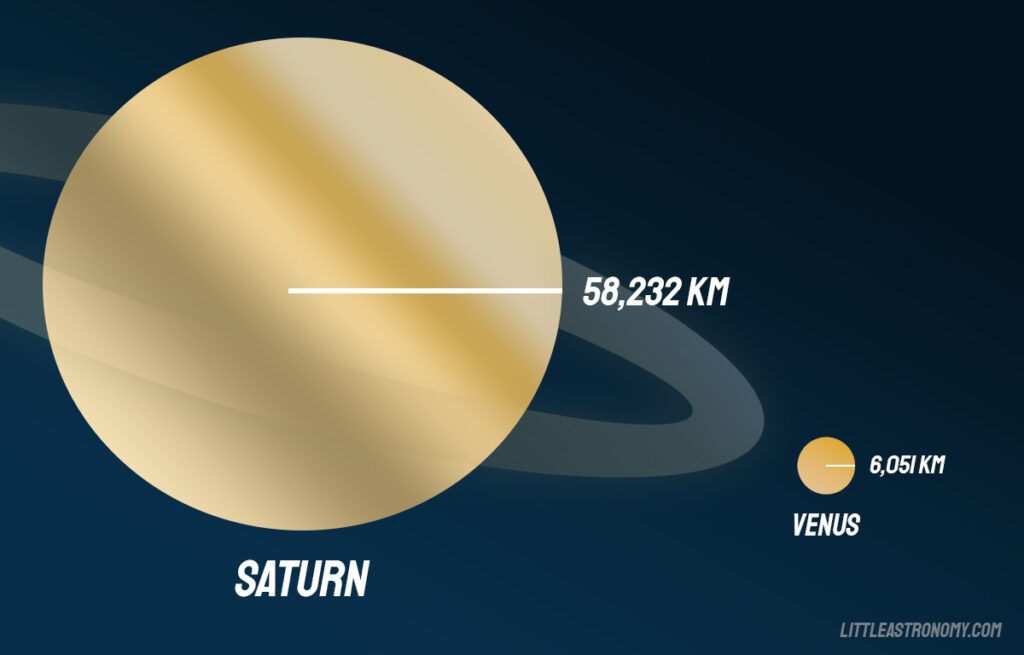
Venus and Saturn similarities
- Both planets orbit the Sun
- Both planets have the same age. Both Venus and Saturn formed approximately 4.5 billion years ago.
- Both planets formed out of the same protoplanetary disc. That is a huge cloud of dust and gas that swirls around a star after it is formed.
- Both planets have “hydrostatic equilibrium”. That means that they are both large enough to be naturally shaped like a sphere due to their own gravity.
- Both planets have cleared their orbits of every other large object.
- The clouds of both planets share some similar colors, like yellow, white, and orange.
- Venus and Saturn were both known to ancient civilizations since they are visible to the naked eye. This means that they don’t have an official discoverer.
- Both planets are named after Roman mythological figures. Venus is named after the goddess of beauty and Saturn after the god of agriculture and wealth.
- Venus and Saturn have very active weather. They both have strong winds and electrical storms.
- Venus and Saturn both have aurora borealis. In the case of Venus, this is particularly curious as it has a very weak magnetic field.
- Both planets are located outside the habitable zone (goldilocks zone) of the Solar system.
- Both planets are uninhabitable to humans.
- Both planets are surrounded by clouds. As a matter of fact, everything that we see through a telescope is just the outer layer of clouds of both planets.
- Despite their size difference, both planets have a similar gravitational pull. This is because Saturn is the least dense planet. If Saturn had a surface, gravity would feel very similar on both planets, and it actually would be very similar to Earth’s.
Venus and Saturn differences
- The most obvious difference between Venus and Saturn is their size. Saturn’s radius is almost 10 times larger than Venus’. You could fit 890 Venus-sized planets in just one Saturn.
- The second difference is obviously the rings. Saturn has a large and dense set of rings that are even visible from Earth. Venus doesn’t have any rings.
- Saturn rotates very fast. It is the second fastest planet in terms of rotation and one day lasts only ten and a half hours despite its large size. Venus on the other hand has the slowest rotation of all the planets.
- Venus and Saturn rotate in opposite directions. Saturn rotates counter-clockwise, like the Sun and most of the other planets, and Venus rotates clockwise. It is very likely that this and its slow rotation are the result of a collision with another planet in the early days of the Solar system.
- Venus has a solid surface. Saturn is made out of gas and doesn’t have a surface.
- Venus is the hottest planet in the Solar system. The average temperature on its surface can reach 464°C (867.2°C). Saturn is very far away from the Sun and doesn’t receive much sunlight so it is quite cold. The average temperature on its outer layer is about -140°C (-220°C).
- Saturn is the planet with the highest number of natural satellites with 145 moons. Venus doesn’t even have a single moon.
- Venus is a very dense planet. It is the second densest only behind Earth. Saturn is the least dense planet in the Solar system.
- Venus travels through space almost 4 times faster than Saturn. It takes Saturn almost 30 Earth years to complete just one year (one orbit around the Sun).
- Saturn is more than 13 times farther away from the Sun than Venus.
- The composition of their atmospheres is very different. The Venusian atmosphere is filled mostly with carbon dioxide. Saturn’s is mostly made out of hydrogen and helium.
Summary
- Venus and Saturn are very different planets despite being formed at the same time from the same cloud of materials.
- Some of the similarities between Venus and Saturn include their age, bad weather, gravitational pull, and outer colors.
- The differences between Venus and Saturn include their size, number of rings, moons, rotational direction, speed, and temperature amongst many others.

